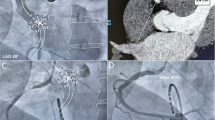Abstract
Background
Catheter ablation of left atrial linear lesions is an effective treatment option for perimitral flutter and is often used as a substrate modification approach for persistent atrial fibrillation. The two most popular mitral isthmus lines are those of the anterior or the posterior mitral isthmus. A comparison of these two mitral isthmus ablation approaches is still pending.
Methods
Patients undergoing catheter ablation either at the anterior or the posterior mitral isthmus were included. Procedural success, conduction block, procedure durations, complications, and the necessity of a coronary sinus ablation were analyzed.
Results
We investigated 80 consecutive patients, 40 (50 %) with an anterior and 40 (50 %) with a posterior mitral isthmus line. Twenty (25.0 %) patients had perimitral annulus flutter; the remainder of the patients had persistent atrial fibrillation. Bidirectional conduction block was achieved in the same proportion in the anterior group (36; 90.0 %) as it was in the posterior group (30; 75.0 %) (statistically insignificant). Duration of procedure (18 ± 12 vs. 34 ± 24 min, p = 0.001), radiofrequency application (11 ± 7 vs. 18 ± 11 min, p = 0.004), and fluoroscopy (2 ± 2 vs. 8 ± 8 min, p < 0.001) values were all significantly lower in the anterior group. Only patients in the posterior line group had to be ablated via the coronary sinus 24 (60.0 %).
Conclusions
Ablation at the anterior mitral isthmus shows the same success rate as the posterior mitral isthmus does. Catheter ablation at the anterior mitral isthmus is associated with significantly shorter procedure durations without the need of a coronary sinus ablation.





Similar content being viewed by others
References
Knecht, S., Hocini, M., Wright, M., et al. (2008). Left atrial linear lesions are required for successful treatment of persistent atrial fibrillation. European Heart Journal, 29(19), 2359–2366.
Matsuo, S., Wright, M., Knecht, S., et al. (2010). Peri-mitral atrial flutter in patients with atrial fibrillation ablation. Heart Rhythm, 7(1), 2–8.
Jais, P., Hocini, M., Hsu, L. F., et al. (2004). Technique and results of linear ablation at the mitral isthmus. Circulation, 110(19), 2996–3002.
Tzeis, S., Luik, A., Jilek, C., et al. (2010). The modified anterior line: an alternative linear lesion in perimitral flutter. Journal of Cardiovascular Electrophysiology, 21(6), 665–670.
Makanjee, B., Klein, G. J., Derval, N., & Skanes, A. C. (2010). An anterior ablation line is preferred for perimitral flutter after heart transplant. Journal of Cardiovascular Electrophysiology, 21(5), 574–576.
Matsuo, S., Yamane, T., Date, T., et al. (2011). Completion of mitral isthmus ablation using a steerable sheath: prospective randomized comparison with a nonsteerable sheath. Journal of Cardiovascular Electrophysiology, 22(12), 1331–1338.
Pak, H. N., Oh, Y. S., Lim, H. E., Kim, Y. H., & Hwang, C. (2011). Comparison of voltage map-guided left atrial anterior wall ablation versus left lateral mitral isthmus ablation in patients with persistent atrial fibrillation. Heart Rhythm, 8(2), 199–206.
Wong, K. C., Lim, C., Sadarmin, P. P., et al. (2011). High incidence of acute sub-clinical circumflex artery ‘injury’ following mitral isthmus ablation. European Heart Journal, 32(15), 1881–1890.
Sawhney, N., Anand, K., Robertson, C. E., Wurdeman, T., Anousheh, R., & Feld, G. K. (2011). Recovery of mitral isthmus conduction leads to the development of macro-reentrant tachycardia after left atrial linear ablation for atrial fibrillation. Circulation. Arrhythmia and Electrophysiology, 4(6), 832–837.
Wutzler, A., Rolf, S., Huemer, M., et al. (2012). Safety aspects of deep sedation during catheter ablation of atrial fibrillation. Pacing and Clinical Electrophysiology, 35(1), 38–43.
Huemer, M., Wutzler, A., Parwani, A., et al. (2015). Left atrial appendage conduction jump for real-time evaluation of conduction block over the anterior mitral annulus line. Journal of Cardiovascular Electrophysiology.
Huemer, M., Wutzler, A., Parwani, A. S., Attanasio, P., Haverkamp, W., & Boldt, L. H. (2014). Mapping of the left-sided phrenic nerve course in patients undergoing left atrial catheter ablations. Pacing and Clinical Electrophysiology, 37(9), 1141–1148.
Willems, S., Klemm, H., Rostock, T., et al. (2006). Substrate modification combined with pulmonary vein isolation improves outcome of catheter ablation in patients with persistent atrial fibrillation: a prospective randomized comparison. European Heart Journal, 27(23), 2871–2878.
Fassini, G., Riva, S., Chiodelli, R., et al. (2005). Left mitral isthmus ablation associated with PV Isolation: long-term results of a prospective randomized study. Journal of Cardiovascular Electrophysiology, 16(11), 1150–1156.
Gerstenfeld, E. P., & Marchlinski, F. E. (2007). Mapping and ablation of left atrial tachycardias occurring after atrial fibrillation ablation. Heart Rhythm, 4(3 Suppl), S65–S72.
Yokokawa, M., Sundaram, B., Garg, A., et al. (2011). Impact of mitral isthmus anatomy on the likelihood of achieving linear block in patients undergoing catheter ablation of persistent atrial fibrillation. Heart Rhythm, 8(9), 1404–1410.
Calkins, H., Kuck, K. H., Cappato, R., et al. (2012). 2012 HRS/EHRA/ECAS Expert Consensus Statement on Catheter and Surgical Ablation of Atrial Fibrillation: recommendations for patient selection, procedural techniques, patient management and follow-up, definitions, endpoints, and research trial design. Europace, 14(4), 528–606.
Jais, P., Hocini, M., O'Neill, M. D., et al. (2007). How to perform linear lesions. Heart Rhythm, 4(6), 803–809.
Makimoto, H., Zhang, Q., Tilz, R. R., et al. (2013). Aborted sudden cardiac death due to radiofrequency ablation within the coronary sinus and subsequent total occlusion of the circumflex artery. Journal of Cardiovascular Electrophysiology, 24(8), 929–932.
Solheim, E., Off, M. K., Hoff, P. I., Schuster, P., Ohm, O. J., & Chen, J. (2010). Characteristics and distribution of complex fractionated atrial electrograms in patients with paroxysmal and persistent atrial fibrillation. Journal of Interventional Cardiac Electrophysiology, 28(2), 87–93.
Beinart, R., Abbara, S., Blum, A., et al. (2011). Left atrial wall thickness variability measured by CT scans in patients undergoing pulmonary vein isolation. Journal of Cardiovascular Electrophysiology, 22(11), 1232–1236.
Author information
Authors and Affiliations
Corresponding author
Rights and permissions
About this article
Cite this article
Huemer, M., Wutzler, A., Parwani, A.S. et al. Comparison of the anterior and posterior mitral isthmus ablation lines in patients with perimitral annulus flutter or persistent atrial fibrillation. J Interv Card Electrophysiol 44, 119–129 (2015). https://doi.org/10.1007/s10840-015-0033-1
Received:
Accepted:
Published:
Issue Date:
DOI: https://doi.org/10.1007/s10840-015-0033-1




